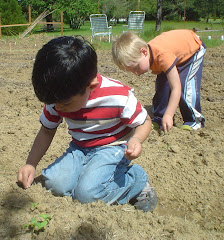 |
| Quite a handsome little greenhouse, don't you think! |
One of the guiding principles of the Sharing Gardens is to
Re-use and Re-purpose as many materials as we can - to keep them out of
burn-piles, and the dump. This carport greenhouse was made with 100%
salvaged and donated materials (we didn't spend a penny!) Such a
beautiful demonstration of what the
Sharing Gardens are all about!
Here
is a greenhouse we made using a metal carport frame, pressure-treated
lumber and plywood. (Finished size - 10' x 20') We had a door and
aluminum windows to use as well, though we've made vents and doors in
other greenhouses by framing them with 2 x 4 lumber and covering in
plywood, or plastic. We've assembled it entirely with screws, which
makes it possible to disassemble and move. Someone donated the aluminum
track (
Spring Lock)
to attach the plastic but it can be expensive to buy it new. On other
greenhouses we've built, we've used long strips of lathe to screw down
the plastic.
 |
| Finished carport greenhouse - side view. |
|
|
|
 |
| North end.
Note unpainted vent-door at peak. Greenhouse is cooled by convection;
cool air comes in lower windows at south end and exits through upper
vent and door. Window on left is also operable. |
 |
| North end from inside. Plywood construction means you can hang shelves/tool rack. |
 |
| South end is all glass (two sliding windows) and greenhouse plastic for maximum light. |
Here are some close-ups for construction details:
 |
| Begin by setting up frame on level ground with the ends facing north and south. |
 |
| Use 2 x 4's to
frame side-walls. Upright metal posts are on bricks or blocks of wood
to keep structure level and prevent it from sinking into the ground. Any
wood that touches the ground should be pressure-treated. |
 |
| Splicing 2 x 4's. The inner board makes a nice support for a shelf or tables. |
|
 |
| The next step
is to install a pressure-treated 6 x 6 across the bottom of the end
walls. In our case, we spliced two shorter pieces together with a
full-length 2 x 6. Keep making the structure level and square. This will
make the rest of your framing much easier. |
 |
| We use metal plumber's tape to secure sides to poles. Note painted cedar 1 x 4 "sill" and metal track (Spring Lock) to attach plastic. |
 |
| Detail of inner walls. If you don't have corrugated fiber-glass, you can simply use more greenhouse plastic, or plywood. |
 |
| Detail - outer corner. Note - we used 2 - 8" lag bolts to fasten lower corner to 6 x 6. |
 |
| Detail - inner corner. |
 |
| South wall, ready for framing and windows. |
Next stage is to frame the end-walls:
 |
| This shows one
of many possible variations for framing end wall. You need framing for
windows or vents and to be able to attach plastic all the way around. |
 |
| North wall framed for door and vent above door. |
Framing details:
 |
| Upper corner detail. 2 x 4's cut with a reciprocating saw (Sawzall). |
More end wall:
 |
| Aluminum-framed, sliding windows for ventilation. |
 |
| South wall framing. |
 |
| Inside north wall (still needs vent above door). |
Attaching plastic:
 |
| This is what the Spring Lock track looks like. The plastic is laid in the track and locked into place with the "wiggle wire". |
 |
| Detail of
corner showing plastic wrapped around and attached on end-wall, and
along 1 x 4 sill on side with Spring Lock and wiggle-wire. |
 |
| Plastic
attached along sill. The nice thing about Spring Lock is that you can go
back and stretch plastic to be taught and even (which we did after this
picture was taken). |
 |
| Skid-free ramp. |
Greenhouse in use:
 |
| Jen and Doreen transplanting peppers. |
 |
| Our new friend Austin, getting a transplanting lesson from Llyn. |
To see other "How To" articles, go to our new and improved site:
http://thesharinggardens.blogspot.com/
If you have questions or suggestions for improvements, please comment below.
































































